Auto Deployment allows you to automatically deploy new versions of packages as they become available in the PDQ Deploy Package Library. (Enterprise mode required.)
The Auto Deployment approval policy determines when your auto deployment schedules will be automatically updated, unless you approve them manually, after Admin Arsenal releases updated packages in the Package Library. The default approval policy is set in Preferences but can be overridden at the package and schedule level.
VIDEO: Admin Arsenal Live! - Auto Deployment
(http://www.adminarsenal.com/pdq-deploy/videos#!admin-arsenal-live!---auto-deployment)
VIDEO: Adding Multiple Packages to an Auto Deployment
(http://www.adminarsenal.com/pdq-deploy/videos#!adding-multiple-packages-to-an-auto-deployment)
This topic includes the following sections:
•Default Auto Deployment Settings in Preferences
•Scheduling an Auto Deployment
•Editing and Adding Steps to an Auto Deployment
Default Auto Deployment Settings in Preferences
The following settings define the default approval policy for new Auto Deployment packages.
To configure auto deployment settings in Preferences:
1.On the Main Console window, click File > Preferences or press Ctrl+Comma.
2.In the Preferences window, click Package Library.
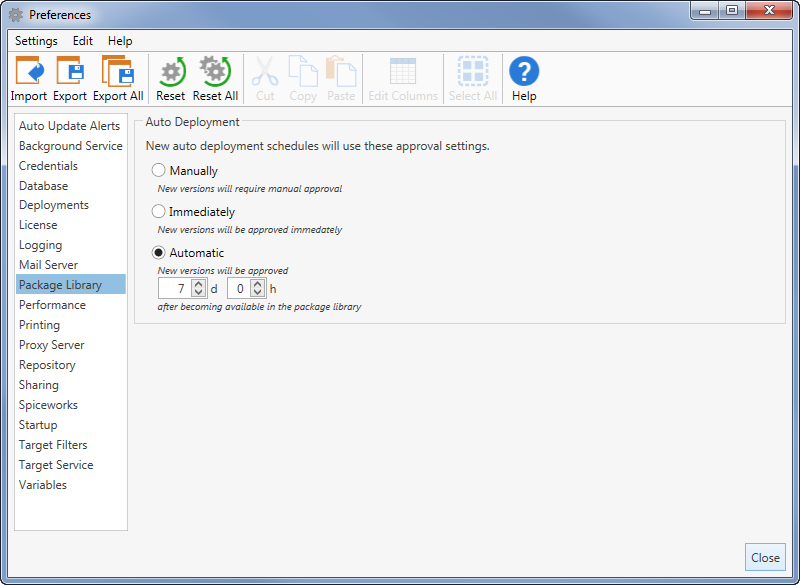
3.On the Package Library page, choose the default auto deployment policy settings.
Your policy settings will depend on your company’s best practices regarding testing and implementing software updates. The options are described in the following table:
Option |
Description |
Manually |
New package versions require manual approval before they are deployed. |
Immediately |
New package versions are immediately approved and are attached to their respective PDQ Deployment schedules. IMPORTANT: Although a package may be immediately approved, it is not actually deployed until its associated schedule runs. |
Automatic |
Sets the interval in days and hours until new package versions are automatically approved. This is enabled by default with a setting of 7 days. |
4.When you are finished, click Close.
NOTE: When you update the default approval policy, the new setting only affects new auto deployment schedules created after you make the change. Existing schedules use the previous default setting or the overrides set at the package or schedule level.
Scheduling an Auto Deployment
To create an auto deployment schedule:
1.On the Main Console window, click Package Library on the tree.
2.Browse the Package Library and select the package you want for an auto deployment.
You can also select and include multiple packages in your auto deployment schedule. This might be for a batch of new or similar computers that need a set of applications installed or updated.
3.On the Package Library page, click Add Auto Deployment > Create New Schedule.
NOTE: You can also add the selected package or packages to an existing schedule. Click Use Existing Schedule, select a schedule, then click OK. You can then Edit the schedule as needed.
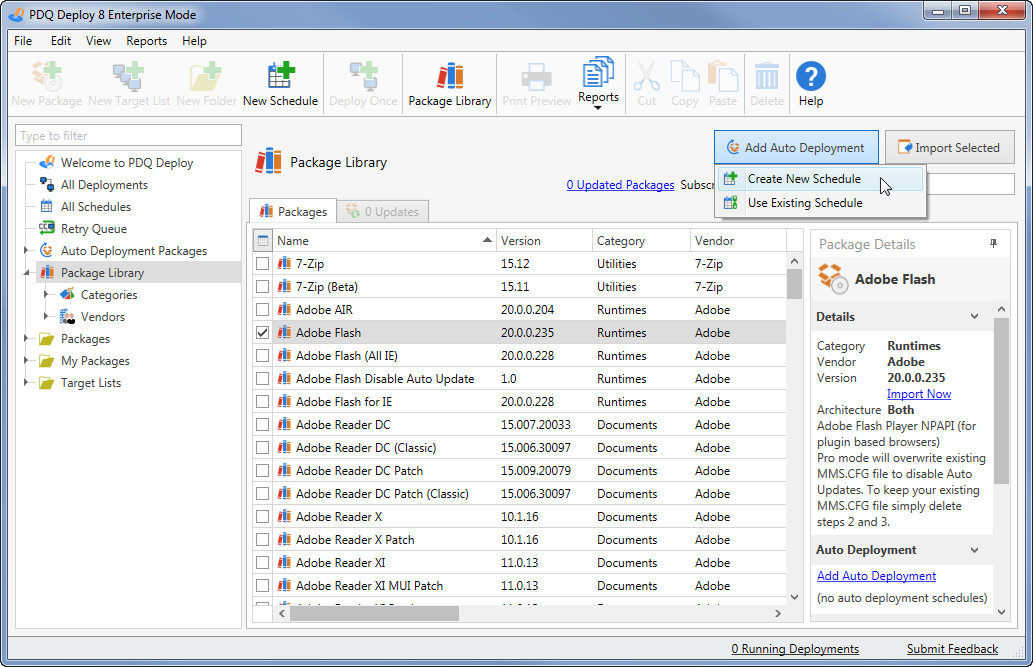
A new Schedule window opens on the Triggers tab.
IMPORTANT: The Packages tab does not appear in the Schedule window until after clicking OK to save and close. Once the Schedule window is reopened, the Packages tab will be visible and all selected packages will be listed.
4.Type a schedule name.
Use a name that makes sense for the new schedule.
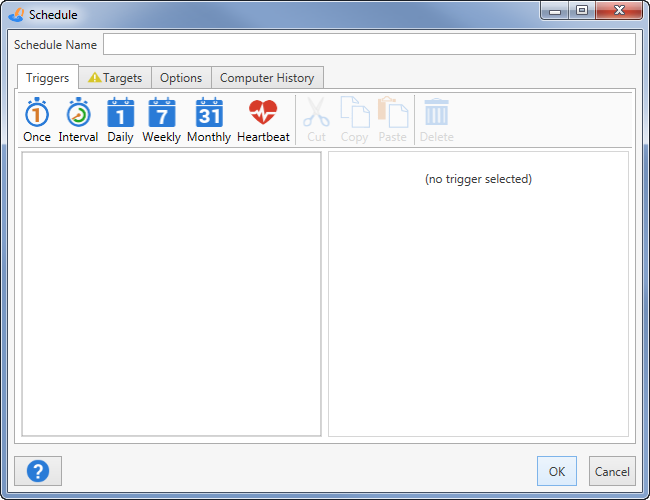
5.On the Triggers tab toolbar, click to select a Schedule Trigger, then define the schedule settings.
For details about configuring triggers, see Creating Scheduled Deployments, Part 2: Schedule Triggers and Settings.
6.On the Targets tab, select the target computers. Alternately, you can also paste a target computer name (or list of names) directly into the Target area of the window. If copying a list of names, ensure that there is only one target computer name per line.
For details about selecting target computers or linking to collections, see Creating Scheduled Deployments, Part 3: Schedule Targets.
7.On the Options tab, configure the deployment settings.
For details about deployment settings, see Creating Scheduled Deployments, Part 4: Schedule Deployment Settings.
8.Click OK to create the schedule.
NOTE: When you create an auto deployment from a package, only the install files are downloaded from the Package Library to your repository. The package itself is not added to your local package collection.
9.(Optional) To see the package or packages attached to the schedule:
a.From the Schedule tab on the Package page, double-click the schedule to open it again, then click the Package tab.
You can rearrange or add and remove packages as needed.
b.Click OK to save any additional changes.
NOTE: The Package Library refreshes every 2 hours and every time PDQ Deploy opens. You also can manually refresh the library on the Main Console window (click View > Refresh or press F5). When packages are updated in the Package Library, PDQ Deploy starts counting down (according to the approval policy) to the time when any auto deployment schedules they are attached to are automatically updated. PDQ Deploy displays auto deployment updates waiting to be approved in the status bar. For information about the Approval Policy, see the Package Library Auto Deployment Settings in Preferences or the approval overrides at the schedule level in step 9.
10.(Optional) To override the default approval policy for the new schedule, select it (from the tree click Auto Deployment Packages > package name, then on the Package page click the Schedules tab > schedule), and do one of the following:
•To approve the updated package immediately, under Schedule Details > New version available, click Approve early.
•To modify the Approval Policy, under Schedule Details > Approval, click change. In the Approval Policy window, change the policy, then click OK.
NOTE: Remember that whenever a new package is approved, it still relies on the schedule to be deployed to your target computers. To override the scheduled deployment, see step 10.
11.(Optional) To run the deployment immediately rather than waiting for its scheduled deployment, do one of the following:
•To run the deployment without changes, on the tree select All Schedules > schedule name, then right-click and select Start Schedule > package name (or under Schedule Details > Details, click Start Schedule > package name).
•To run the deployment using the Deploy Once window with the ability to change deployment options, on the tree select Auto Deployment Packages > package name, then on the Package page click the Schedules tab > schedule, right-click the schedule name and select Deploy Once (or press Ctrl+D or under Schedule Details > Details, click Deploy Once, or right-click the package name in the tree and select Start Auto Deployment > package). For more information, see Deploying an Auto Deployment Package with Deploy Once.
•To run the deployment using the Deploy Once window for multiple auto deployments and/or regular packages, on the Main Console window, select the packages you want to deploy (Shift+click or Ctrl+click), this will open the Multiple Packages page where you can select Deploy Once. For more information, see Deploying Multiple Packages with Deploy Once.
editing and adding steps to an auto deployment
Auto Deployment Properties can be edited and steps can be added in the Package Window. For example, you may need to add steps to the Auto Deployment if you would like to include a message requesting all work be saved due to an upcoming reboot, as well as the reboot step itself.
IMPORTANT: The steps of the Auto Deployment Package itself cannot be added, deleted, or edited.
To edit an existing Auto Deployment:
1.On the Main Console window, select the Auto Deployment Package that you wish to edit.
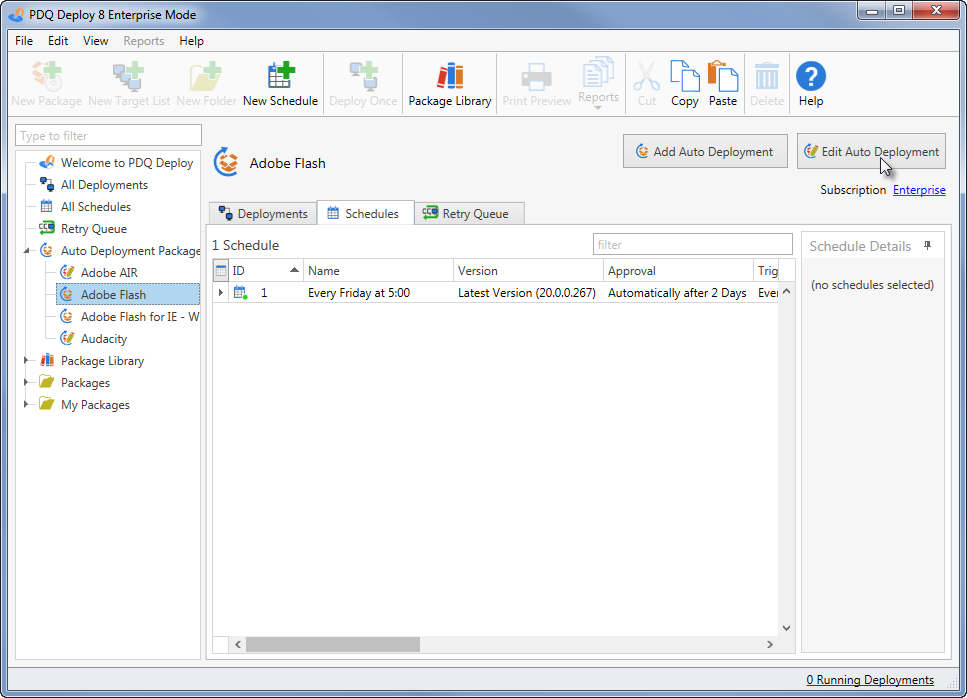
2.Do one of the following:
•On the Auto Deployment page, click Edit Auto Deployment.
•Double-click the Auto Deployment package name from the tree (or right-click and select Open).
•Click File > Open (or press Ctrl+O).
| The Auto Deployment Package Window opens with the Auto Deployment Properties selected, and includes a section for Pre-Auto Deployment Steps and Post-Auto Deployment Steps. |
For more information about the Auto Deployment Properties, see Auto Deployment Properties.
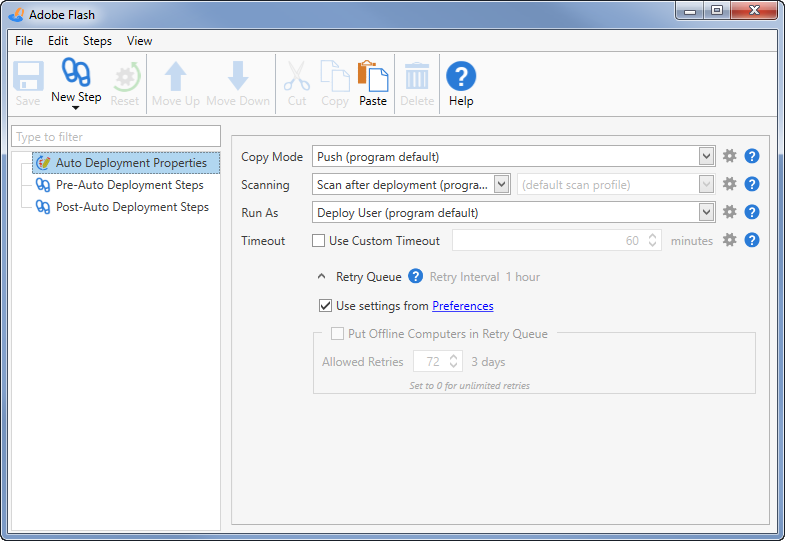
3.To modify the package, see the following table for a list of tasks and details.
As you progress through the Auto Deployment editing process you should periodically save changes. You can also close (and save) the Auto Deployment package window, then continue later.
Task |
Details |
Edit Auto Deployment Properties |
To edit the basic properties of the auto deployment, click Auto Deployment Properties in the tree. For details, see Auto Deployment Properties. |
To add a step that will run immediately before the auto deployment starts, click Pre-Auto Deployment Steps in the tree, on the New Step page, select the step type you want (or click Steps > New Step or the New Step button and select the step type you want). For details, see Step Properties and click on the step type you are adding. |
|
To add a step that will run directly after the auto deployment completes, click Post-Auto Deployment Steps in the tree, on the New Step page, select the step type you want (or click Steps > New Step or the New Step button and select the step type you want). For details, see Step Properties and click on the step type you are adding. |
|
Move a Step |
To move a step, click and drag the step to its desired location. The tool tip will display a green checkmark |
Edit a Step |
To edit a step you have added: 1.Select the step in the tree. 2.To edit the deployment properties, click the Details tab. 3.To edit the step properties unique to the step type, do the following: •To edit the conditions that must be met for a step to run, click the Conditions tab. •To edit additional step level options, such as the credentials used to execute the step on the target and error settings, click the Options tab. For details, see Step Properties and click on the step type you are adding. |
Disable/Enable a Step |
To disable a step you have added or enable a step that is currently disabled: 1.Select the step in the tree. 2.Right-click and toggle from Enabled to Disabled. If a step is disabled, the name of the step is struck-through and the step will be skipped during deployment. This feature enables administrators to “turn off” steps that they may want to enable in the future without deleting the step itself. |
Delete a Step |
To remove a step that you added, select the step, then click Delete |
Restore original Auto Deployment settings |
To remove all customizations on the Auto Deployment package, click Reset |
4.When you have finished editing the Auto Deployment, click Save ![]() (or press Ctrl+S), then close the Auto Deployment window.
(or press Ctrl+S), then close the Auto Deployment window.
| The Auto Deployment Package icon will now include a pencil |
For details on deploying the Auto Deployment package immediately using Deploy Once, see Deploying an Auto Deployment Package with Deploy Once.
Auto deployment properties
Auto Deployments have the following general properties (click Auto Deployment Properties at the top of the Step list).
Option |
Description |
|
Defines how PDQ Deploy copies deployment files to target computers. When files (such as installation files) are copied to a target, PDQ Deploy can use either Push or Pull Copy Mode. By default, PDQ Deploy uses Push Copy Mode. You can change the default Copy Mode in Preferences > Performance or override the default here. See Copy Mode in Performance Preferences for more information. VIDEO: Understanding Push and Pull Deployments
(http://www.adminarsenal.com/videos#!pdq-deploy:-understanding-push-and-pull-deployments) |
||
Push |
Copies files to the target computers from the PDQ Deploy computer. This method is best if the package’s install files are located on the PDQ Deploy computer. This option is the default copy mode defined in Preferences. Bandwidth throttling applies to all simultaneous file copies combined. |
|
Pull |
Sends lists of files to the target computers which then pull the files from a centralized location. This method works best in WAN environments where the files may be on a file server closer to the target computers than the computer where PDQ Deploy is running. For this method to work, all files need to be accessible using a UNC path (e.g. \\server\share\installer.msi). WARNING: Files on fixed or mapped drives are not accessible to the target computers; therefore, a valid UNC path must be provided. Note Bandwidth throttling is not enforced when using Pull Copy Mode. |
|
Select whether or not PDQ Inventory scans target computers after a deployment to identify what is installed on each computer. If you have a package that doesn't install an application, you may want to disable inventory scanning for the package. IMPORTANT: This feature requires PDQ Inventory version 3.1 or later in Pro or Enterprise mode. Additionally, the target computer must already be in PDQ Inventory with a name or hostname that matches the name used in PDQ Deploy. Set the Program Default in Preferences > Deployments or override the default here. |
||
|
Use Program Default |
Uses the default Scanning configuration defined in Preferences. |
Scan after Deployment |
Initiates an inventory scan from PDQ Inventory after a deployment to identify what is installed on each workstation. Scan after Deployment attempts to scan target computers even if deployments fail. This feature can be very helpful in maintaining up-to-date inventory for target machines. The target computers must already be in PDQ Inventory with names or hostnames that match the names used in PDQ Deploy. You may choose which Scan Profile to use. The default Scan Profile is defined in PDQ Inventory in Preferences > Scan Profiles. You can choose to scan with any Scan Profile that has been configured in PDQ Inventory. It is common to use either the Applications or Standard scan profiles. |
|
Do Not Scan |
Does not scan target computers after deployment. |
|
During a deployment, a Windows service is created on the target computer. The Run As setting determines how this service "logs on" after it is created. The default (and generally appropriate) setting is Deploy User. Change the default in Preferences > Credentials or override the default here. For a sample demonstration of the Run As options, see the following video. VIDEO: Deployment Run As Options
(http://www.adminarsenal.com/videos#!deployment-run-as-options) |
||
Deploy User |
Executes deployments on target computers in a non-interactive session as the Deploy User. This option is the default Run As setting defined in Preferences. This setting is appropriate for the vast majority of deployments. Consequently, this is the recommended setting. |
|
Executes deployments that include both silent and interactive steps. This setting is the same as Deploy User with one important exception—the Windows process running the deployment is run in an interactive session. This setting is most appropriately used for individual deployments that require user input, but the overall process still requires Administrator rights that logged on users may not have. Because these types of deployments are more specialized and because running the deployment in interactive mode requires more processing resources, it is recommended that you apply this setting only as needed at the Package level. |
||
Local System |
Executes deployments using the Local System account on the target computer. PDQ Deploy connects to the target computer using the Deploy User credentials, copies the specified files, creates the PDQDeployRunner service, then instructs the service to log on as Local System. This setting is used only for installations that require Local System. These types of deployments are very rare. Consequently, it is recommended that you apply this setting only as needed at the Package level. IMPORTANT: Packages that run as Local System are not able to access network resources. |
|
Logged on User |
Attempts to run packages in interactive mode as the Logged On User of the target machine. This setting is used to deploy applications that are installed per user or when the Logged on User needs to provide information for the deployment to succeed such as a license key. It can also be used to modify the HKEY_CURRENT_USER registry hive for the Logged on User or to access user-specific settings such as %APPDATA% or the Logged on User’s user directory. These types of deployments are highly specialized. Consequently, it is recommended that you apply this setting only as needed at the Package level. |
|
Specifies how many minutes the deployment runs before being timed out by the server (requires Pro or Enterprise mode to modify this setting). The default value is 60 minutes. This timeout applies only to the duration of a deployment to a target computer. The timeout does not include the initial process of copying installation files to the target. Change the default in Preferences > Deployments options or override the default here. It is best practice to set the shortest timeout interval as the global default in Preferences and increase the timeout interval in individual packages. For example, if you typically deploy small packages such as browser, Java, or Adobe reader updates, you may choose to set the global timeout interval to 20 minutes. You could then increase the timeout interval for individual packages that take longer to install, such as a Windows Service Pack or a package containing many nested packages. |
||
Enable or disable the Retry Queue and modify the number of retries for the package. The Retry Queue Interval, and several other settings, can only be modified in Preferences > Deployments > Offline Settings. |
||
|
Use settings from Preferences |
Uses the global Offline settings defined in Preferences. When you select this option, the subsequent Retry Queue settings are disabled. |
Put Offline Computers in Retry Queue |
Enables the Retry Queue. By default, target computers that are unreachable or offline during a deployment are held in the Retry Queue and deployment is retried. The advantage of this feature is that offline computers are automatically queued for re-deployment. This simplifies the process of ensuring that critical updates are deployed to all target computers. It is recommended that you enable this option per package rather than applying it globally in Preferences. TIP: Some packages with specific, non-critical functions should not use the Retry Queue. For example, it is not advisable to use this option with a package that only reboots target computers because offline computers were probably turned off to begin with and, depending on the target computers’ availability, PDQ Deploy may reboot users’ computers at inopportune times. |
|
Allowed Retries |
Sets the number of retry attempts for an offline computer. This applies per target per deployment. The default setting is 72. To set unlimited retries, set this value to 0. |
|
© 2016 Admin Arsenal, Inc. All rights reserved.
Admin Arsenal is a trademark of Admin Arsenal, Inc. All other product and company names are the property of their respective owners.
Help Version: 8.1.0.0